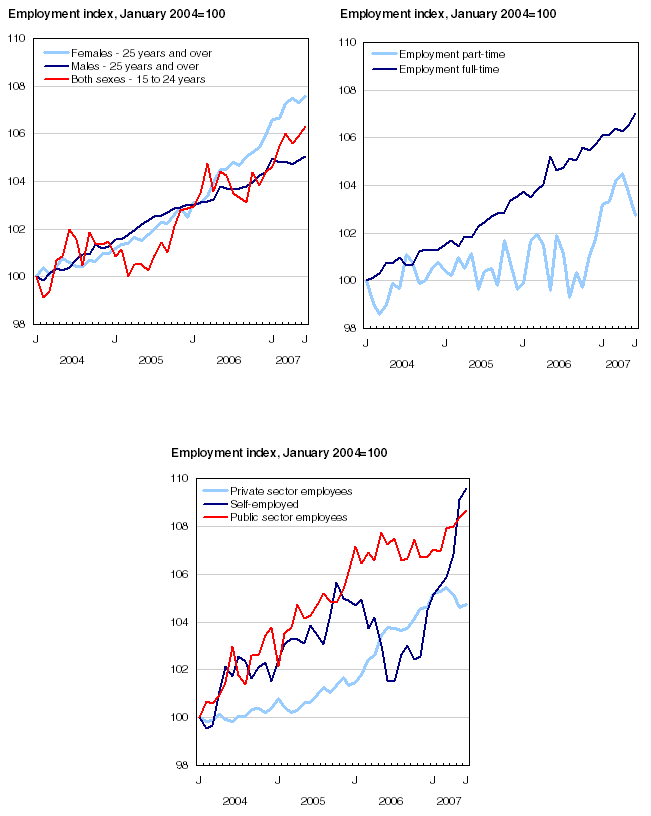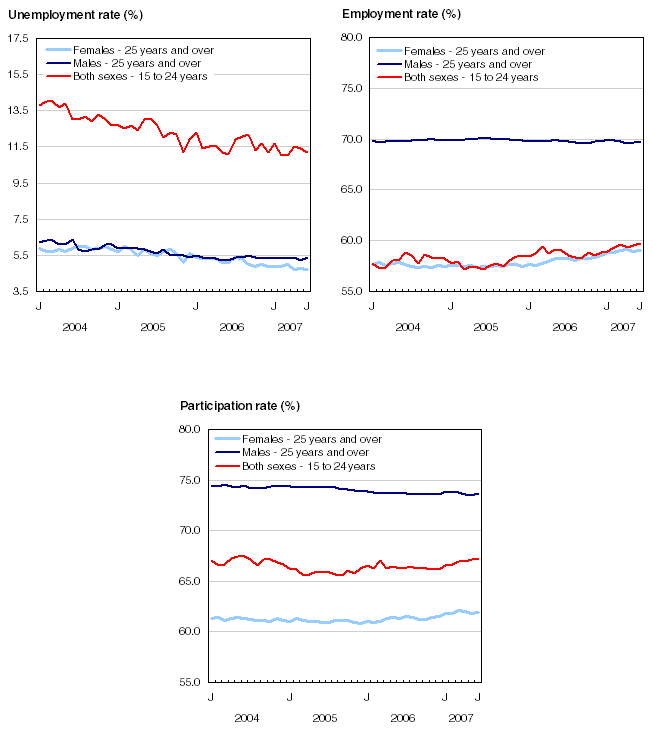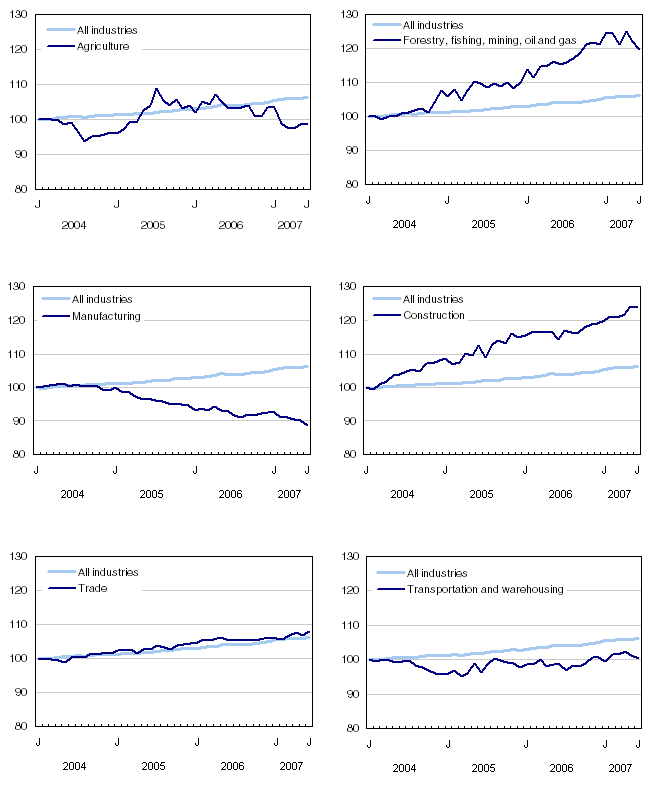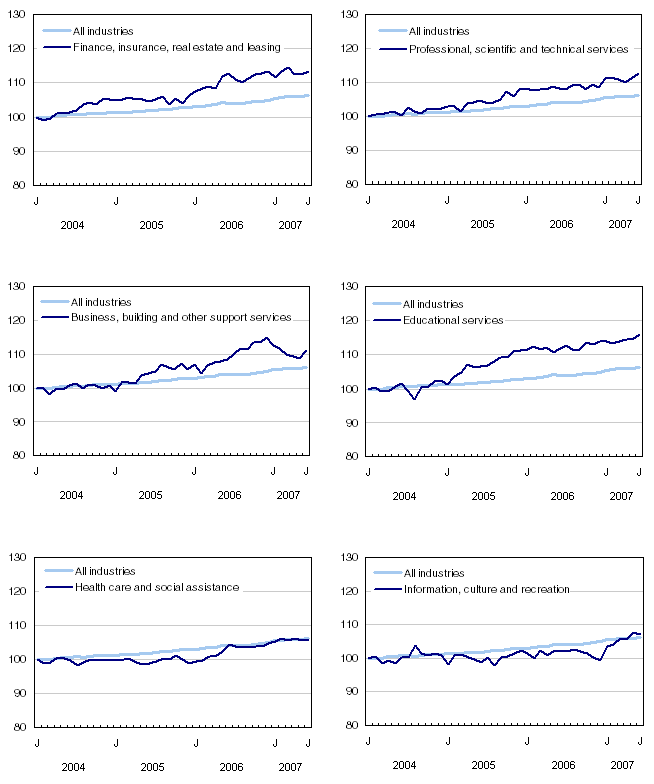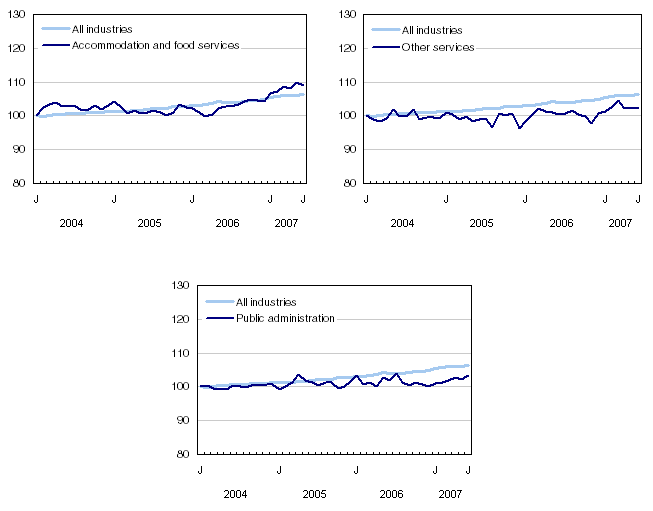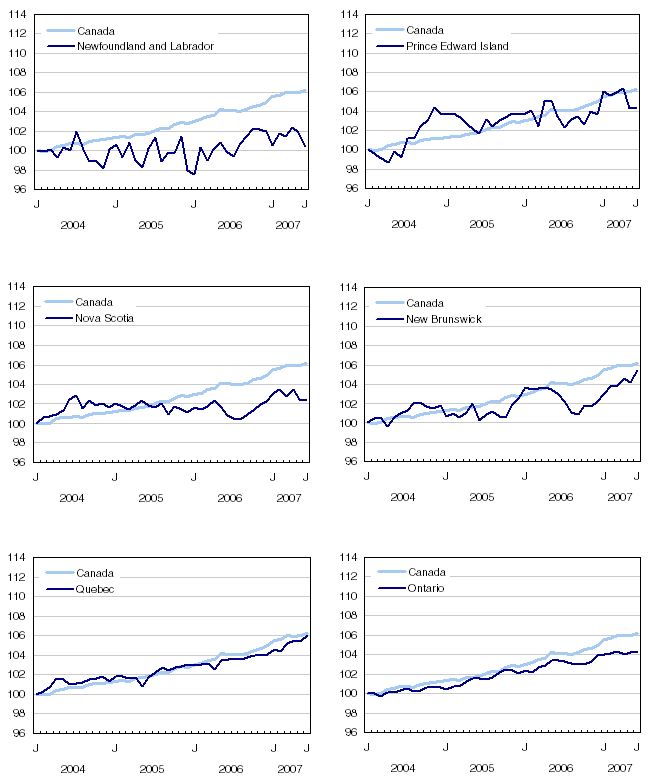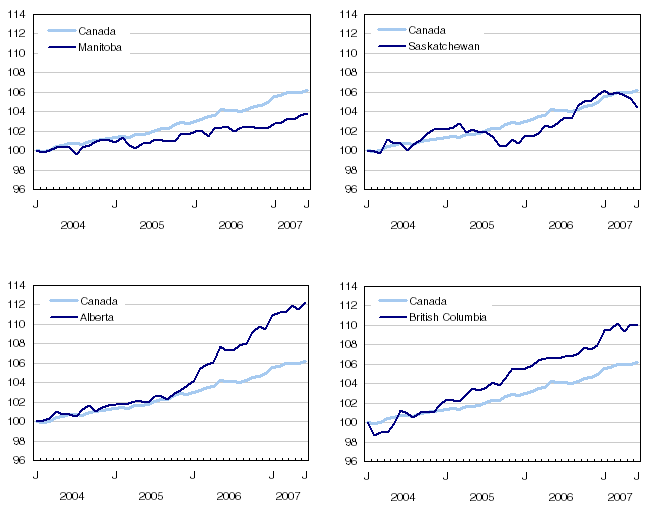Common menu bar links
Not for release before 7 A.M. E.D.T. Friday July 6, 2007
June 10 to 16, 2007
Archived Content
Information identified as archived is provided for reference, research or recordkeeping purposes. It is not subject to the Government of Canada Web Standards and has not been altered or updated since it was archived. Please "contact us" to request a format other than those available.
Analysis — June 2007
Employment growth resumed in June, up an estimated 35,000, following little change in April and May. Despite this gain, the national unemployment rate remained at 6.1% for the fifth consecutive month, as more people entered the labour force this month in search of work.
The added employment in June brings overall gains for the first half of the year to an estimated 197,000 or 1.2%, similar to the growth observed over the same period last year.
For the second straight month, there was an increase in full-time work while part-time fell. Adult women accounted for most of this month’s increase in full-time and all of the decline in part-time employment.
There were more people working in Quebec, Alberta and New Brunswick in June. Over the first half of the year, provinces with employment growth above the national average of 1.2% were: New Brunswick (+3.1%), Alberta (+2.5%), British Columbia (+1.9%), Quebec (+1.8%) and Manitoba (+1.6%). In contrast, there have been employment declines over the first half of the year in Newfoundland and Labrador as well as Saskatchewan.
Ontario, which accounts for nearly 40% of total employment in Canada, registered growth of only 0.4% over the past six months. Employment growth in Nova Scotia and Prince Edward Island was also below the national average since the start of the year.
The largest employment increases in June were in retail and wholesale trade; business, building and other support services as well as educational services. Manufacturing employment, however, continued on its downward trend.
Over the first half of the year, manufacturing employment has plummeted by 4.3% while there has been robust growth in a number of industries including, information, culture and recreation; accommodation and food services; construction; utilities; as well as trade.
During the second quarter of the year, average hourly wages rose by an estimated 3.2% compared to the same three-month period last year. The most recent comparable Consumer Price Index increased by 2.2%.
More workers in sales but fewer on the factory floor
Employment in retail and wholesale trade in June jumped by an estimated 31,000. Nearly all of the increase in June for trade occurred in Quebec.
The gain in trade was offset by a continued slump in manufacturing employment which was down 31,000 in June, mainly in Ontario. Over the last 12 months, factory employment was down by an estimated 103,000 nationally. Losses were widespread across the sector, with transportation equipment manufacturing the most affected.
In June, employment increased by 15,000 in business, building and other support services, mainly in Ontario and Alberta. Educational services was up 14,000 for the month, with the largest gains in Quebec.
The number of people working in natural resources declined by an estimated 7,000 in June, mostly in Ontario and Newfoundland and Labrador. This leaves employment in the industry slightly below the level at the start of 2007, but still well above June of last year.
Full-time employment growth among adult women
For the second consecutive month, there was growth in full-time employment while the number of part-time workers declined. In June, full-time employment increased by an estimated 63,000, partly offset by a decrease of 28,000 in part-time work.
The increase in full-time employment in June affected mainly adult women aged 25 and over. In fact, this was the only group to experience a significant employment gain in June, up an estimated 15,000, as the number of adult women working part-time fell, but was more than offset by gains in full-time. Overall employment among adult men and youths was little changed.
The unemployment rate in June stands at 4.7% for adult women and 5.4% for adult men. In July 2006, the unemployment rate for both men and women was matched at 5.4%. Since then, the unemployment rate for men has remained relatively stable, while the rate for women has been steadily declining, resulting in a widening gap. Over the last 12 months, employment growth among adult women (+2.9%) has been much stronger than for adult men (+1.3%).
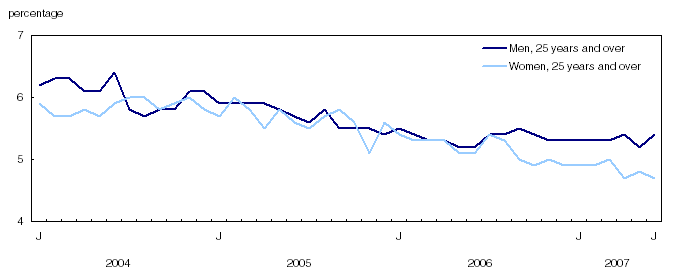
Self-employment trend is up
Although the number of self-employed edged up only 12,000 in June, this type of work has shown a strong upward trend since last October with gains since then totalling 174,000 (+7.0%). Several industries have increased their number of self-employed workers including accommodation and food; educational services; ‘other’ services; and finance, insurance, real estate and leasing.
Over this same eight month period, the number of employees has grown more slowly, up 99,000 (+0.7%) with gains of 62,000 in the private sector and 37,000 in the public sector.
Quebec led the country in employment growth for June
Employment in Quebec increased by an estimated 22,000, all in full-time work, pushing the unemployment rate down 0.3 percentage points to 6.9%, the lowest in 33 years. With this month’s employment increase, the employment rate reached an all-time high of 61.1%. So far this year, employment in the province has increased by 70,000 (+1.8%) with the largest gains in accommodation and food; trade; and construction. There have been declines however in factory employment.
In June, there were 12,000 more workers in Alberta, bringing total gains for the province during the past six months to 47,000 (+2.5%). Increases over the first half of the year occurred in a number of industries including trade; business, building and other support services; construction as well as natural resources. Despite more employment in June, the unemployment rate was unchanged at 3.8% as more people entered the labour force. The participation rate for the province, at 74.2%, attained a new record in June and continued to be above that of all other provinces.
Employment also increased in New Brunswick, up 4,000, bringing the unemployment rate for the province to a 33-year low of 6.8%. Over the first half of the year, the number of employed New Brunswickers increased by 3.1% (+11,000), the strongest rate of growth in the country. Just over half of this gain occurred in information, culture and recreation as well as educational services. The employment rate rose 0.7 percentage points in June to 59.6%, the highest rate ever.
Employment growth cools for Saskatchewan
There were an estimated 4,000 fewer employed people in Saskatchewan in June, leaving employment in the province down 1.1% (-6,000) from the beginning of the year. This is in contrast to the robust gains observed throughout 2006 when employment grew by 4.9%. Despite recent employment losses, the unemployment rate at 4.4% in June remains among the lowest in the country.
Employment also declined in Newfoundland and Labrador in June, down 3,000, leaving employment in the province slightly below the level of last December. The unemployment rate edged up 0.2 percentage points in June to 13.1%.
While employment in Ontario was little changed in June, growth continued to be dampened by employment losses in manufacturing, down 19,000 for the month and 50,000 over the first half of the year. Despite strength in various service industries, Ontario’s employment growth for the first six months of the year (+0.4%) continues to lag well behind the national average.
Although employment in British Columbia was little changed in June, it has grown by 1.9% so far this year with the largest increases in retail and wholesale trade as well as construction. A substantial increase in the number of people working part-time in June was offset by a decline in full-time employment.
The Labour Force Survey also collects labour market information about the North. This information is not seasonally adjusted and is produced in the form of three month moving averages. Comparisons should only be made on a year-over-year basis.
The North
The proportion of people aged 15 and over working remains high in Canada’s three northern territories. For the 10 largest communities in Nunavut, the employment rate increased to 64.8% in June (3-month average of April, May and June), up from 59.6%, one year ago.
In contrast, the employment rate in the Yukon fell from 73.5% in June 2006 to 70.0% in June 2007 (3-month average). In the Northwest Territories, there was little change in the labour market over the past year, with the employment rate at 73.3% this June.
From May to August, the Labour Force Survey collects labour market information about young people aged 15 to 24 years who were attending school full-time in March and intend to return to school in the fall. Survey results for May and June give an early indication of the summer job market for older students aged 20 to 24, however, many students aged 15 to 19 were not yet out of school for the summer. Survey results for July and August will provide further insight into the summer job market for younger students. The published estimates are not seasonally adjusted, therefore comparisons can only be made on a year-over-year basis.
Summer employment promising for 15 to 16 year-olds and 20 to 24 year-olds
The employment rate for students - those aged 15 to 24, studying full time in March and who plan to return to their studies in September - reached a 17-year June high of 52.4%, up 1.5 percentage points from June 2006.
A higher share of students aged 15 to 16 years were employed in June (31.6%), up 3.1 percentage points from June of last year. This is the highest June employment rate these students have experienced since June 1991. The increase in employment was all in part-time. This is not surprising since these teenagers were still preoccupied with school and exams in mid-June and those with jobs nearly all work part-time. Compared to June of last year, the unemployment rate for this group is down to 16.8%, a decrease of 2.5 percentage points.
Students aged 20 to 24 years also found more employment opportunities in June (72.1%) compared to last year (69.7%), however, the employment rate is still far from the all time high reached in June 1989 (79.7%). The increase in employment was all full-time.
The only students to experience little change in their employment rate were those aged 17 to 19. With more of this group entering the labour force in search of work, their unemployment rate increased to 12.3% in June from 10.3% 12 months earlier.
Note to readers
The Labour Force Survey estimates are based on a sample, and are therefore subject to sampling variability. Estimates for smaller geographic areas or industries will have more variability. For an explanation of sampling variability of estimates, and how to use standard errors to assess this variability, consult the Data Quality section in this publication.
The 2006 Labour Force Historical Review on CD-ROM (71F0004XCB, $209) is now available.
